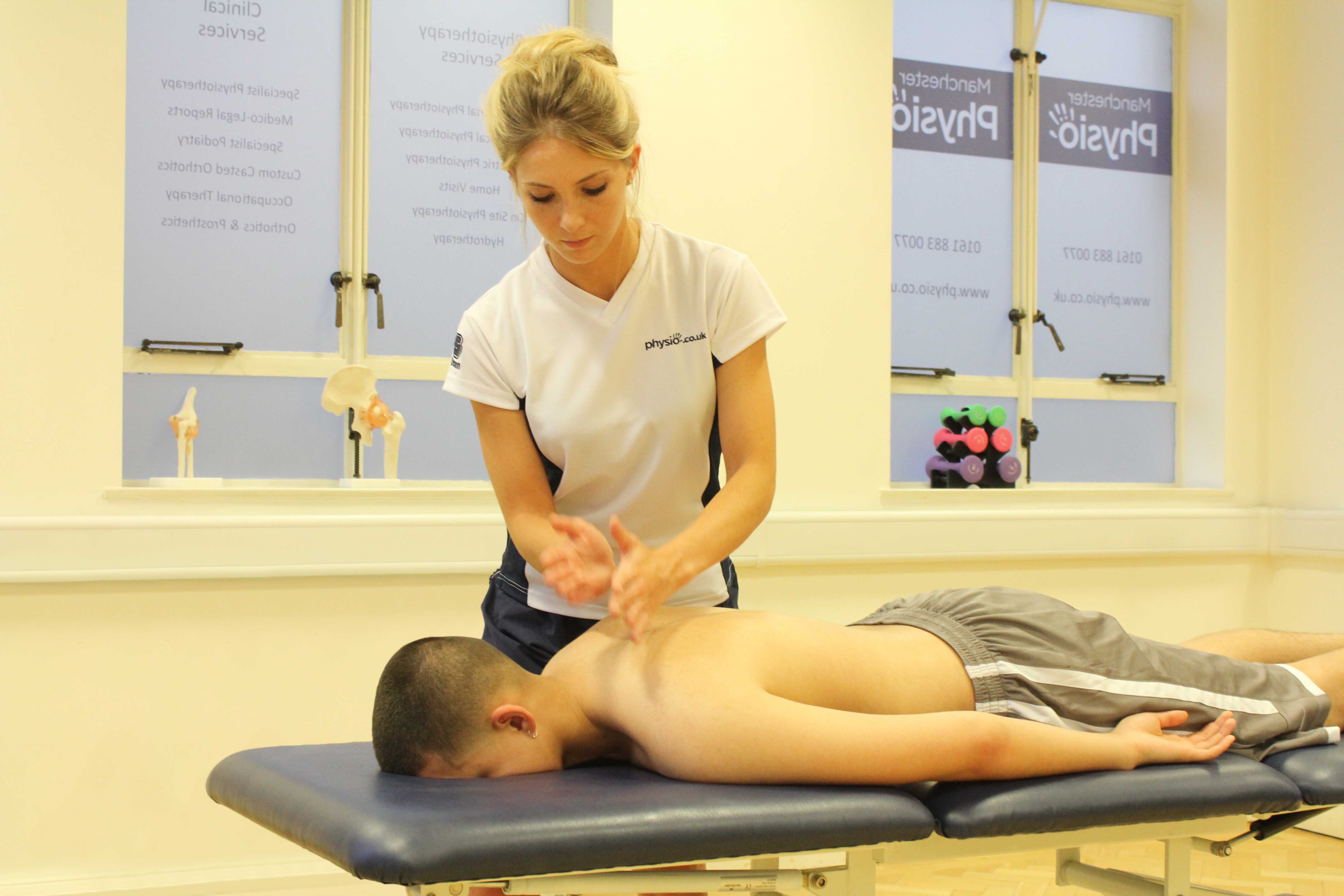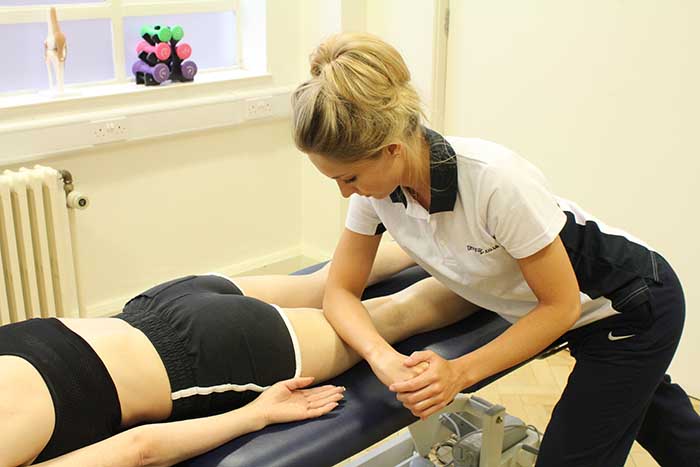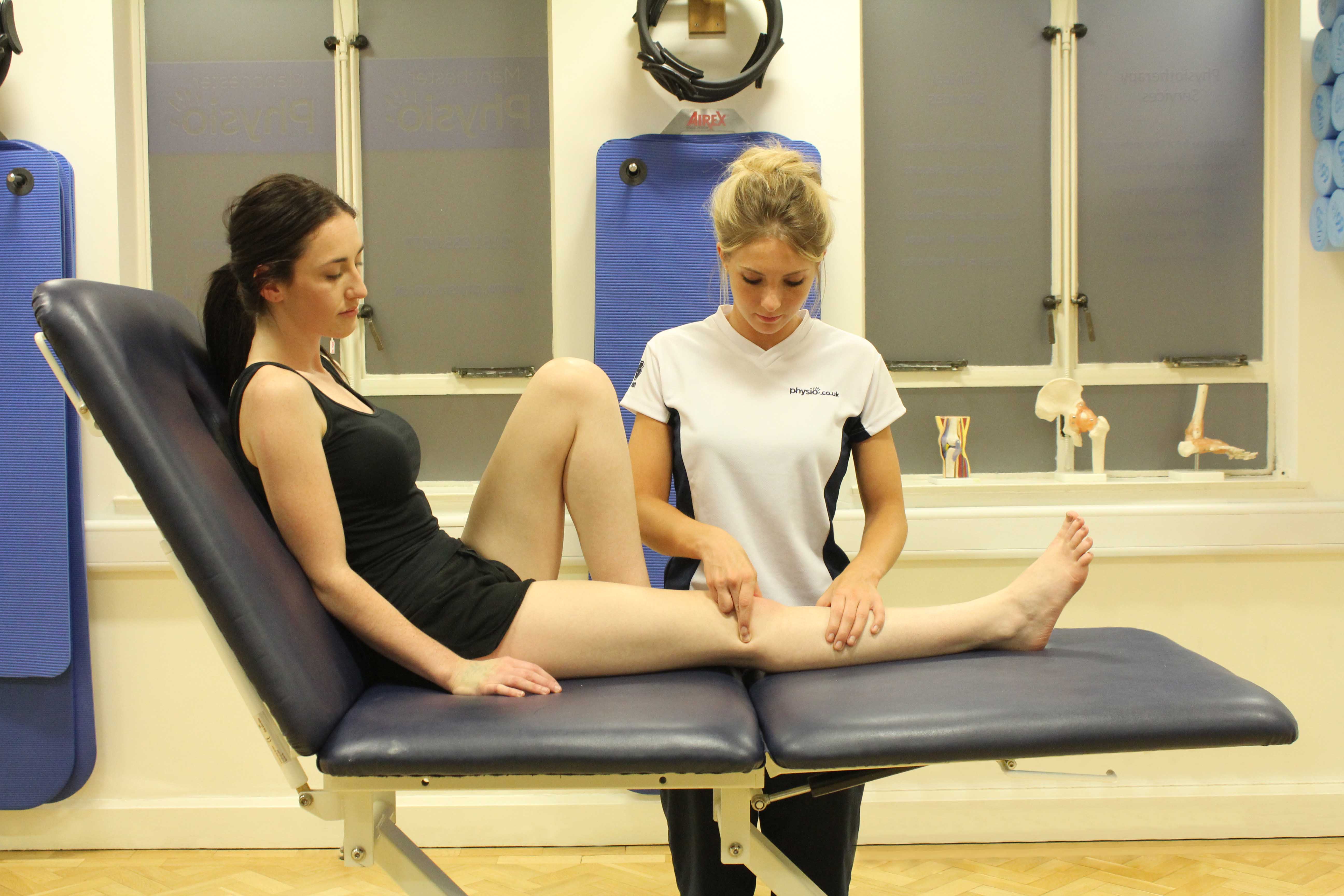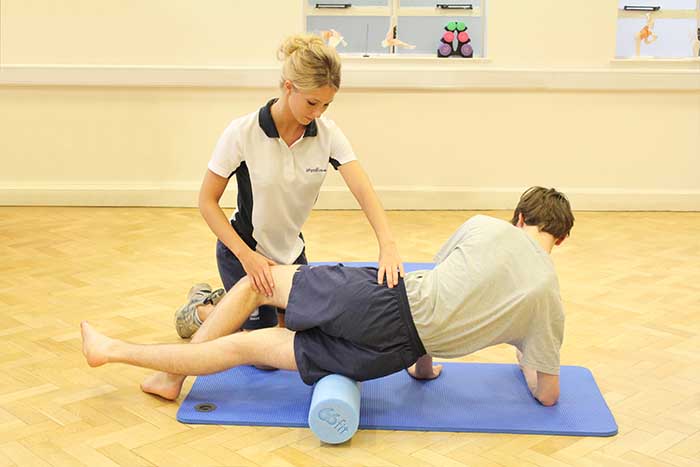A benefit often gained through massage is maximised performance. Maximising performance means that a person is able to participate in an event without muscles easily fatiguing, weakening or becoming injured. A range of different types of massage are used to maximise performance as well as a variety of different techniques. Maximising performance can help keep muscles strong, healthy and less likely to injure. Our massage therapists at Physio.co.uk maximise performance through massage to help pre event and speed up recovery.
What are the most appropriate types of massage to maximise performance?
A variety of different massages can be used to maximise performance. The most suitable types of massages used include:
 Above: Hacking percussion massage technique applied to trapezius and latissimus dorsi muscle
Above: Hacking percussion massage technique applied to trapezius and latissimus dorsi muscleThe most common types of massage used to maximise performance include sports massage, deep tissue massage and remedial massage.
Sports massage is a common type of massage used to maximise performance. A sports massage is a manual form of massage used on areas containing soft tissues. A sports massage can be used to benefit any person, not just sports athletes. Performance can be maximised through sports massage as muscles are loosened and stretched. Muscles are loosened and stretched as temperature increases due to friction created between the skin and fingers. Loosened muscles increases range of movement to help maximise performance.

Deep tissue massage is often used to maximise performance. A deep tissue massage involves applying a firm pressure to the treatment area, aiming to get deep into muscles to help relieve tightness. A deep tissue massage can maximise performance as it helps to reduce restriction by breaking down adhesions. Adhesions are bundles of hard tissues that build-up within muscles increasing pain and restricting movement. Breaking down adhesions through deep tissue massage can relieve pain and decrease restriction resulting in maximised performance.
Performance can be maximised through remedial massage. A remedial massage is a type of massage that manipulates superficial and deep tissues to help them become healthier and repair any damage. A remedial massage can also often be therapeutic for a person as it encourages the relaxation of muscles. Repairing damaged muscles and encouraging the relaxation of muscle both help to maximise performance.
What techniques are used to maximise performance?
A wide range of techniques can be used to maximise performance. The most common techniques used include:
 Above: Transverse friction massage of illio-tibial band
Above: Transverse friction massage of illio-tibial bandThe most common techniques used to maximise performance include effleurage, kneading and skin rolling.
Effleurage is often used to maximise performance. Effleurage is a more gentle technique that involves applying varied pressure onto the treatment area using flattened hands and fingers. The pressure applied during effleurage is varied depending on the person's preference. Effleurage encourages an increase in muscle temperature by increasing blood circulation. Increasing muscle temperature improves tissue elasticity and flexibility. Increasing tissue elasticity reduces muscle tightness and tension allowing muscles to more freely. Allowing muscles to move more freely without restriction helps to maximise performance.
Kneading is a technique regularly used to maximise performance. Kneading is where muscle tissues around the treatment area are pulled and squeezed. Kneading is often used to increase blood flow and reduce muscle tightness. The pulling and squeezing actions used help to stretch the muscles enabling muscles to loosen and relax. Loosened and relaxed muscles maximise performance as range of movement is increased and restriction is decreased.
A common technique used to maximise performance is skin rolling. Skin rolling involves using fingers and thumbs to pick and roll skin. Skin rolling helps to relieve restriction caused by both fascia and muscle. The layers of fascia and muscle are separated during skin rolling as the temperature of muscular and connective tissues both increase. Increasing temperature of tissues, improves their flexibility reducing tightness and restriction and increasing range of movement. Increasing range of movement through skin rolling helps to maximise performance as muscles are less likely to injure during activity and muscles are able to stretch to their full length with no restriction.

When can a massage help to maximise performance?
There are many situations a massage can help to maximise performance. The most common situations include:
Situations a massage can help to maximise performance include pre event, as part of a training programme and post injury.
A massage can help to maximise performance pre event. Before a person takes part in an event, it is essential that they are physically prepared. A massage encourages an increase in circulation around the body. An increase in circulation helps to flush out metabolic wastes enabling a person to carry out the activity for longer without tiring or fatiguing. Increased circulation also provides muscles with an increase in oxygen and nutrients as well as increasing muscle temperature. Increasing oxygen and nutrients provides muscles with an increase in energy for the event as well as maintaining their strength and health. Increasing muscle temperature allows muscles to loosen and stretch, decreasing restriction. Loosened muscles enables a person to put their muscles on full stretch without pulling, straining or tearing muscle fibres.
Massage can help as part of a training programme to maximise performance. During a training programme, muscles can become fatigued, over worked and sometimes damaged. A massage helps to maximise performance during a training programme by speeding up recovery. Recovery is improved as circulation increases. Circulation of blood provides muscles with essential oxygen and nutrients needed for the repair of damaged tissues. Circulation of the lymphatic system removes waste products and toxins that slow down the recovery process more efficiently. Maximising performance through massage as part of a training programme also maintains relaxation of muscles reducing a build-up of stress and tension.
A common situation massage can help to maximise performance is post injury. After an injury, muscles tighten, pain increases and a build-up of metabolic wastes can occur. A massage encourages a speed up in recovery by removing metabolic wastes more efficiently and reducing muscle tightness to therefore reduce pain. When recovery is improved, the time taken to return to training reduces. Enabling a person to return to training more quickly can maximise performance. Massage also helps to prevent injury from reoccurring, further maximising performance after injury.
What are the physiological effects of massage to maximise performance
There are various physiological effects of massage that maximise performance. The most common physiological effects include:
The most common physiological effects that maximise performance include increased temperature, increased lymphatic drainage and increased oxygenation.
Increased temperature is a common physiological effect that occurs to maximise performance. An increase in temperature is where both superficial and deep tissues increase in temperature. The temperature of fascia can also be increased. Fascia is a fibrous layer of connective tissues found beneath the surface of the skin. Fascia often causes restriction in movement, increasing pain and decreasing performance levels. An increase in temperature occurs when friction created between the skin and fingers encourages an increase in blood flow. An increase in blood flow rises the muscle tissues and connective tissues temperature. Increasing temperature increases the elasticity of muscle and fascia tissues, decreasing restriction and increasing range of movement. Increasing range of movement can maximise performance as well as reducing the risk of injury.
A common physiological effect to maximise performance is increased lymphatic drainage. Lymphatic drainage involves the stimulation of the lymphatic system, increasing lymphatic flow. The lymphatic system is made up of a series of small vessels called lymph vessels. Metabolic wastes are transported through the lymph flow to be removed from the body. When a build-up of metabolic wastes occurs within muscles, effects such as swelling, fatigue and weakness can occur, decreasing performance. Stimulating the lymphatic system encourages metabolic wastes to be removed more efficiently, reducing swelling, fatigue and weakness and maximising performance.
A physiological effect to maximise performance is increased oxygenation. Increased oxygenation is where an increase in blood flow supplies tissues within the body with an increase in oxygen. When a person is part of a straining programme or is going to take part in an event, muscles may not be prepared. An increase in blood flow occurs as vasodilation and capillarisation increases. Vasodilation is where blood vessels widen and capillarisation is where the quantity of capillaries surrounding a muscle increases. The availability of oxygen increases when vasodilation and capillarisation occurs, providing muscles with an increase in energy as well as maintaining their strength. Increasing energy available for muscles to use and maintaining muscular strength maximises performance by reducing muscle fatigue and weakness.
Summary
Maximised performance is essential for athletes to help them recover quickly from injury prevent injuries from occurring again. Many types of massage can be used to maximise performance including sports massage, deep tissue massage and remedial massage. A variety of techniques including effleurage, kneading and skin rolling are used within a massage to maximise performance. Maximising performance can help pre event, as part of a training programme and post injury. There are a range of physiological effects that occur to maximise performance, the most common including increased temperature, increased lymphatic drainage and increased oxygenation. Our massage therapists at Physio.co.uk maximise performance through massage to help prevent injury, improve muscle condition and maintain muscle strength.
How can I arrange a massage to maximise performance?
The easiest way to arrange a massage to maximise performance at Physio.co.uk is to email us at office@physio.co.uk or call us on 0800 033 7800.
You can also book an appointment online and save £10

 0330 088 7800
0330 088 7800






































